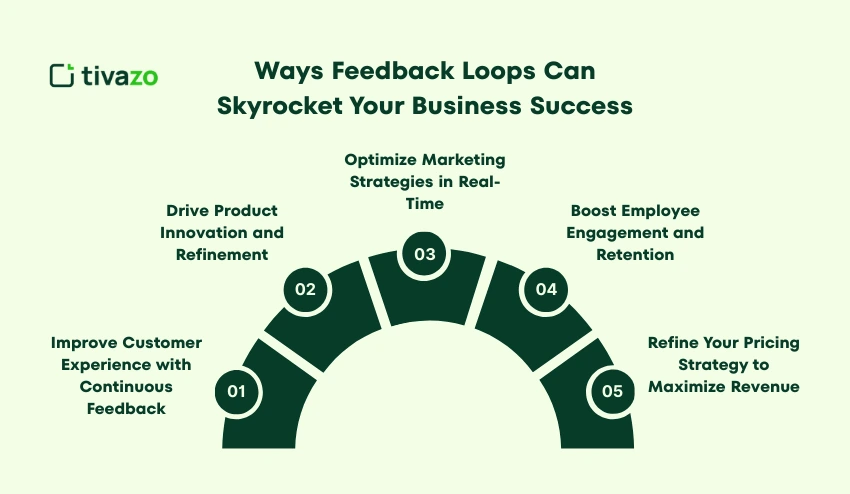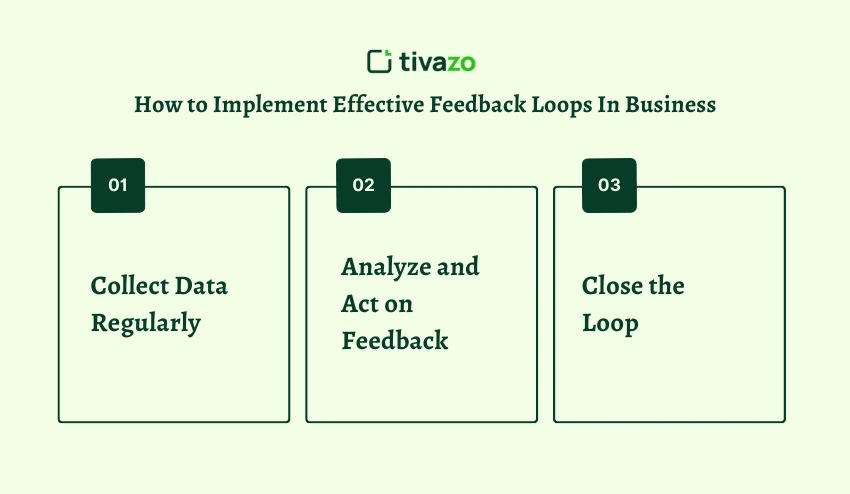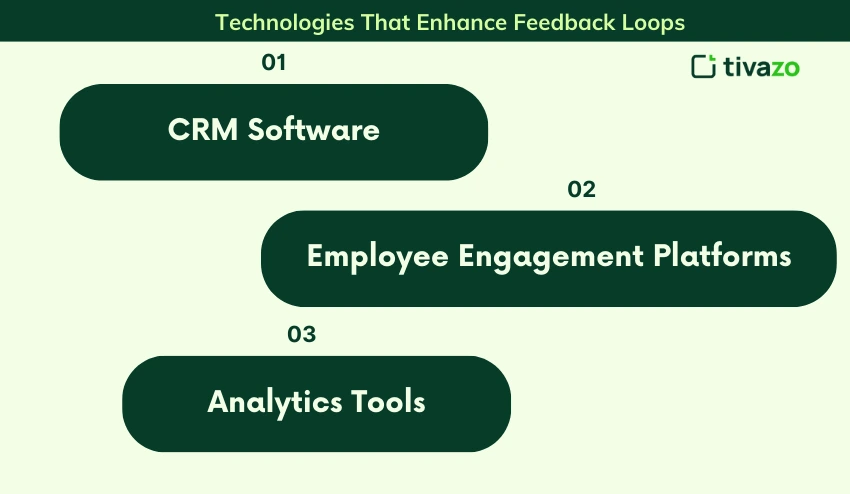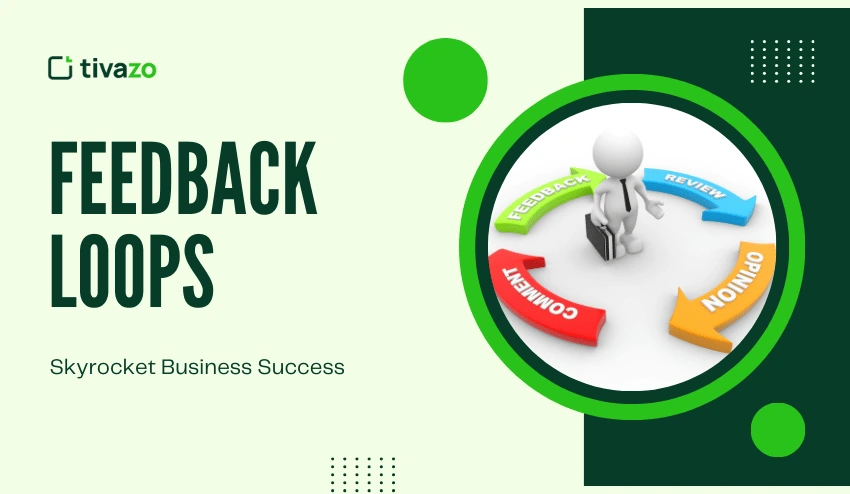In today’s fast-paced business world, feedback loops are an invaluable way for businesses to drive success. The feedback loops not only help drive businesses forward but also help them pivot quickly, both to customer needs and market trends but also internally to address any dynamics. Picture a world where every action you took provided you with exponential returns which fueled the entire operation. This is the efficacy of feedback loops, where the inputs and outputs are continuously fed back into the system to drive improvement and creativity.
In this blog, we are going to extract five feedback loops from your business that will help you evolve to create a culture of growth, innovation, and success.
Key Highlights:
- What Are Feedback Loops
- Ways Feedback Loops Can Skyrocket Your Business Success
- Feedback Loops Impact Your Bottom Line
- Implement Effective Feedback Loops in Your Business
- Common Pitfalls to Avoid When Using Feedback Loops
- Technologies That Enhance Feedback Loops
- Advanced Feedback Loop Strategies
What Are Feedback Loops?
A feedback loop is simply a cycle of action and response where the output of a system is returned as an input to the next cycle of activity to influence subsequent rounds of action. Stated simply, it is just a loop of action and reaction. It is a device that allows change to take place based on what happened before, self-correcting its system, and evolving into something better over time.
In business, feedback loops are essential for:
- Customer satisfaction
- Employee engagement
- Product innovation
- Marketing strategies
Feedback loops, whether through customer feedback, employee surveys, or market trends, help to guarantee that businesses are always evolving, improving, and responding to an ever-changing environment.
5 Ways Feedback Loops Can Skyrocket Your Business Success

1. Improve Customer Experience with Continuous Feedback
Customer experience is essential to success in business. If businesses are continuously receiving customer feedback through surveys, reviews, or direct interactions, they are receiving a crucial understanding in a continuous constructive feedback activity that will help to refine their products or services. As feedback is an ongoing activity, businesses will begin to respond better to customer expectations, as they are now more attuned to customer satisfaction, hence developing more loyal customers. Satisfied customers, who feel that their voice was heard, are more likely to be long-term repeat customers and potentially advocates for the brands they support. Thus, it supports businesses’ attempts to ensure customer retention and increase the customer lifetime value.
2. Drive Product Innovation and Refinement
To stay competitive in an increasingly competitive world, you have to stay ahead through innovation. Product development incorporates feedback loops to ensure your products are iterating based on customer needs continuously. Gathering insights from early adopters, beta testers, and even your general customer base can provide you with feedback about what is effective and needs work. Feedback loops will allow businesses to iterate on their product development, making improvements based on real data about their users’ experience, fixing problems, and bolstering new features.
3. Optimize Marketing Strategies in Real-Time
Marketing is another area in which feedback loops can yield exciting results. Using data in real time to analyze customer responses to a marketing campaign means you can modify the content of the marketing ads immediately to improve performance and optimize results. We can use A/B testing, customer feedback inquiries, and tracking analytics to receive feedback on our marketing. Observing the value in what we hear from our customers, whether our messaging resonates with our market base, our athletics, or our offer resonates, or all are viable pieces of feedback that can be utilized to optimize speedily and have the best chance that the campaigns you embark on will achieve optimum engagement and conversions.
4. Boost Employee Engagement and Retention
Feedback loops can also be valuable for employees, not just customers. Consistently pulling in employee feedback on job satisfaction, management style, and company culture allows leaders and businesses to investigate areas in need of improvement. Creating an environment where employee feedback is wanted leads to improved ownership, engagement, and belonging for employees. Engaged employees are usually more productive, creative, and loyal; these key metrics can also impact employee retention.
5. Refine Your Pricing Strategy to Maximize Revenue
Pricing is one of the most sensitive areas of a business. Feedback loops to test pricing allow a company to remain in tune with customer preferences and market conditions that might affect competitiveness or profitability. Feedback about customer willingness to pay can help the business determine the quantity needed for each price. By monitoring competitors and market trends, a business can make decisions about pricing and developing pricing models that maximize profitability.
How Feedback Loops Impact Your Bottom Line
The Ripple Effect on Profitability
Feedback loops play a significant role in refining products or services, but they can also directly affect your bottom line. If done well, feedback loops will result in a continuous feed of feedback that leads to better performance of your company. Here is how:
Real-World Examples:
- Amazon:
Amazon uses feedback from its customers to drive its recommendation engine. Based on shopping history and reviews, the recommendation engine uses feedback in real-time to continually build a more personalized shopping experience while increasing sales and loyalty. In addition, improving delivery and customer service through feedback will lead to better overall experiences with the company. Businesses can also enhance their Amazon performance by partnering with SalesDuo, which provides expert services to optimize listings, manage reviews, and boost overall marketplace success. - Apple:
Apple relies on feedback from developers and users to regularly release updates to its products, particularly to fix bugs and implement new features. This ongoing feedback loop puts Apple in a unique position to stay “ahead of the curve” of market demand to increase performance and innovation of its iPhone or macOS products. Their willingness and ability to incorporate feedback not only increases performance but also puts pressure on competitors to remain competitive.
How to Implement Effective Feedback Loops in Your Business

Step 1: Collect Data Regularly
To set up effective feedback loops, you need to gather data consistently. Use surveys, polls, social media listening, and sales data to keep a pulse on customer and employee sentiment.
- Surveys & Polls: Directly ask for feedback on products or services.
- Social Media Listening: Monitor online conversations and mentions.
- Sales Data: Analyze purchasing patterns to spot trends.
Step 2: Analyze and Act on Feedback
The next step is to analyze the data, sort it and take action. Implementing improvements or changes based on feedback should happen as quickly as possible.
- Categorize: Find patterns or recurring themes.
- Patterns: Look for connections to business problems.
- Action: Make changes quickly based on patterns noticed.
Step 3: Close the Loop
When changes have been made based on the feedback, communicate that feedback to the person who provided the feedback. This shows the person you are truly listening and you validated their feedback to strengthen the relationship/deal with the person.
- Inform Stakeholders: Inform customers/employees regarding any feedback changes.
- Show Appreciation: Thank the customer or employee for their feedback.
- Measure Impact: Record results to confirm improvements made.
Common Pitfalls to Avoid When Using Feedback Loops
1. Neglecting Actionable Feedback
Collecting feedback is just the first step act upon it quickly. Not taking timely action can lead to user frustration and disengagement. You want to take the time to carefully evaluate the feedback and act upon your findings, so they feel valued and that their feedback matters.
2. Failing to Close the Loop
If you do not follow up on user feedback and engage them about how their feedback led to changes, they are likely to disengage from the feedback loop altogether. Closing the feedback loop is extremely important to build trust and improve user engagement.
3. Overloading with Feedback Requests
Reaching out too often for user feedback can lead to user fatigue and cause them to disengage because they feel overwhelmed. Feedback requests should be staggered and relevant to the user’s experience. Multiple feedback requests can lead to disengagement and/or inaccurate feedback from the user.
4. Ignoring Negative Feedback
Sometimes, negative feedback is characterized as a complaint. This can be a dangerous way to think because we squander opportunities to improve and correct problems. Address the complaint using a prompt response process because you want to show a commitment to continuous improvement.
5. Focusing Only on Quantitative Feedback
The feedback we can collect internally from surveys and polls is great, but if we have to depend strictly on quantitative data, we lose the context and experiences that were made around that quantitative feedback. We can get far greater detail as a customer by hearing comments (in the right experience) that they had an opportunity to write open-ended comments (even if prompted). Talking directly with customers sometimes can give a better understanding of the emotions that drove customers to respond, or not respond, in the way they did.
Technologies That Enhance Feedback Loops
Technologies That Enhance Feedback Loops are as follows:

1. CRM Software for Customer Feedback
CRM software enables you to track customer feedback and manage customer interactions to make sure you don’t miss any valuable information. CRM is a tool that allows organizations to track customer feedback to then improve service to the customer and improve relationships by recognizing and addressing the customer’s concerns in a timely and effective manner.
2. Employee Engagement Platforms
Employee feedback and engagement software allow employees to give feedback anonymously through software dedicated to engagement. These valuable engagement and feedback tools improve the workplace culture and track employee satisfaction while enhancing communication between employees and management knows and what the employee morale, culture, and engagement appear to be.
3. Analytics Tools for Real-Time Marketing Feedback
Analytics tools like Google Analytics and social media insight analytics provide businesses with the ability to track campaign performance in real-time. These tools provide the analytics necessary for marketers to make adjustments to campaigns to optimize ongoing strategies. Analytics can provide measurable ROI and improved customer engagement by leveraging immediate customer feedback and behavioral patterns.
Advanced Feedback Loop Strategies for Scaling Your Business
1. Multi-Channel Feedback Collection
Providing multiple ways to collect feedback (e.g. social media, in-app surveys, campaign emails) will help to engage a more diverse set of voices to get a holistic picture on consumer attitudes.
2. Predictive Analytics for Anticipating Needs
Investigate predictive analytics to create foresight into potential customer needs and trends based on your unique vertical before it hits the masses. This helps companies plan ahead instead of reacting.
3. Integrating AI for Continuous Improvement
Utilize AI to help streamline your feedback collection, analysis, and actions. The faster the company can complete the feedback loop, the faster you are able to scale improvements with accuracy.
Conclusion
Feedback loops present a cornerstone of business strategy in contemporary organizations. By conducting surveys and collecting feedback from customers, employees and other stakeholders, a business can continuously engage in reflection and utilization of stakeholder satisfaction and sentiment to create a self-improving feedback loop model to power growth of innovation, growth and profitability. In the business world, our conversations never stop! Now it’s time to try these feedback loop systems and watch your business succeed.




